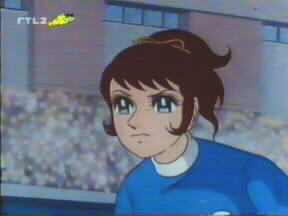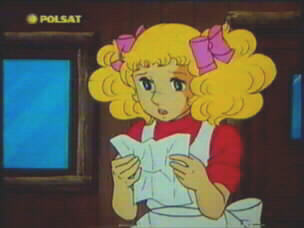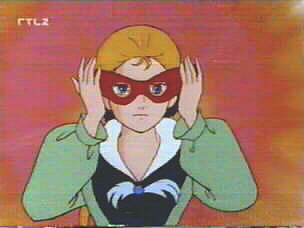 Webpage
Webpage
ACE O NERAE (=Aim for the Ace!/Jenny Jenny (1988-90), 26 eps.
 A classic shoujo tennis anime, in which Oka Hiromi (Jenny),
initially a poor player, succeeds though determination and the hard work
of coach Munkata. The opening & closing credit artwork is astonishing,
with character designs that bear a close resemblance to those of Onisama
E (=Dear Brother), and the remainder has the rather stylised action
sequences typical of sports anime. The Italian series is adapted from a
set of Japanese OVAs which were made as a sequel to the Japanese TV series
(1973). After the death of a close friend, "Jenny" takes up tennis again,
briefly visits America in pursuit of a lover, and competes in a tournament.
The tennis sequences are more than usually stylised, with the emphasis
purely on determination and power play.
A classic shoujo tennis anime, in which Oka Hiromi (Jenny),
initially a poor player, succeeds though determination and the hard work
of coach Munkata. The opening & closing credit artwork is astonishing,
with character designs that bear a close resemblance to those of Onisama
E (=Dear Brother), and the remainder has the rather stylised action
sequences typical of sports anime. The Italian series is adapted from a
set of Japanese OVAs which were made as a sequel to the Japanese TV series
(1973). After the death of a close friend, "Jenny" takes up tennis again,
briefly visits America in pursuit of a lover, and competes in a tournament.
The tennis sequences are more than usually stylised, with the emphasis
purely on determination and power play.
Like Onisama E, it seems intended for more mature viewers; all the
principal characters appear adult. Polsat showed the Italian edition with
a Polish overdub. I've watched many of the Italian episodes; it's hard
to follow, but the art is great (also beautiful women in tennis dresses...)Jenny
MILA SUPERSTAR = "Attack no.1" On court | On court
 Though
old and animated in a dated style, this is one of the most interesting
series screened on sat. TV. It's a 'sports anime', and unlike most of the
other series, it's utterly Japanese asides from the dubbing, being set
in Japan and permeated with the Japanese ethos.
Though
old and animated in a dated style, this is one of the most interesting
series screened on sat. TV. It's a 'sports anime', and unlike most of the
other series, it's utterly Japanese asides from the dubbing, being set
in Japan and permeated with the Japanese ethos.
This is an old sports anime, made around 1970, and it's about high
school volleyball, and in particular one girl, 'Mila' who works her way
up through the sport to international level. Rather unusually for anime
shown in Europe, this is a thoroughly Japanese series, with a Japanese
setting, kanji on signs, and a very Japanese ethos of teamwork, "ganbatte"
etc. Typically, in the rather sadistic opening credit sequence, our heroine
is pelted with volleyballs till she falls to the ground.
It's a straight drama, not a comedy, and the characterisation and scripting
are exceptionally good, so that even if you know nothing about volleyball
and care less, you still want to know how each game ends.
I was quite astonished by the sophistication of the opening episode,
in which 'Mila' , at this point 12 years old, transfers to a high school
on the coast near Mt Fuji. In an early scene, the maths teacher is grumbling
that none of his pupils understand a geometry problem - are they stupid
or just asleep in class? At this point he spots Mila, who really IS asleep.
On waking up, rather slowly, she gives the correct answer to the maths.
problem, and wonders why the teacher is cross. He remarks sarcastically
that if she is ill or tired she should go to the sick room. Mila says that
she'll do that, and picking up a couple of brown leaves that have blown
in through the open window, remarks that she'll release them outside, and
breezes out. She releases the leaves from a terrace. Weird girl!
The teachers are taking an unusual interest in Mila, a bright child
whom they hoped might light a fire under their dozy pupils. Instead, she
turns down the overtures of the school volleyball team and on the strength
of the 'leaf' episode, takes up with the school 'rebels' who prefer dancing
to a transistor radio under the trees to joining school clubs.
Well! As a portrait of a potentially disruptive school pupil, this
could hardly be bettered!
[ RTL2 have about 101 episodes). BTW, there are several Attack No.1
movies (in Japanese).
In a later sequence of episodes, Mila, now 14 years old, and a budding
volleyball star, attends the same school where an obsessed coach with a
damaged right arm is grooming the girls to win a national championship.
There's the usual rivalry and accusations of being in love with Coach or
vice versa.
Permeated with the Japanese ganbatte! train-till-you-bleed spirit,
the series contains levels of violence that some viewers might find quite
disturbing. Since a girl gets pelted to the ground with volleyballs in
one opening credit sequence, Mila
hit by ball you can guess what the rest of it is going to be like.
Fans of Japanese anime and culture should check it out.
I watched this most mornings. Good script, rooted in real life, and
takes its subject totally seriously.
For more info see Vince Ho's Shoujo
Anime List.
CANDY CANDY
 A
classic shoujo anime, set in the USA, following the story of Candy White,
a tomboy-waif from Michigan. Visually, it is somewhat reminiscent of "Lady
Georgie", another period romantic drama. In a later episode, Candy works
as a nurse
at a railroad construction project. I've only seen two episodes, and detail
on the series can be hard to come by, but check out the Shoujo
ML Archive. Highly rated by some fans.
A
classic shoujo anime, set in the USA, following the story of Candy White,
a tomboy-waif from Michigan. Visually, it is somewhat reminiscent of "Lady
Georgie", another period romantic drama. In a later episode, Candy works
as a nurse
at a railroad construction project. I've only seen two episodes, and detail
on the series can be hard to come by, but check out the Shoujo
ML Archive. Highly rated by some fans.Japanese name: Candy Candy Japanese name: ƒLƒƒƒ"ƒfƒBƒLƒƒƒ"ƒfƒB Dates: October 1, 1976-February 2, 1979 Number of episodes: 115 Production Company: Toei Animation Character Designer(s): Mitsui Shindo Music: Takeo Watanabe Voice Actors (regular characters): Genre(s): drama |
GEORGIE (= Lady Georgie) Georgie & brother | Georgie's bracelet
 I'm
fairly sure this is one of those made-for-export Japanese series, for I
remember reading about it somewhere. It has run several times on TM3. Also
has a few scenes that only the Japanese would dare include!! Setting, 19th
cent. Australia, near the sea.
I'm
fairly sure this is one of those made-for-export Japanese series, for I
remember reading about it somewhere. It has run several times on TM3. Also
has a few scenes that only the Japanese would dare include!! Setting, 19th
cent. Australia, near the sea.
Georgie, who is actually quite unrelated to the other characters, though
she doesn't know this, lives on a farm with her two 'brothers', Abel and
Arthur, and their mother. In the early episodes Mr Bateman is also present,
but later dies in an accident. In the middle episodes I've seen, Abel starts
behaving rather awkwardly towards Georgie, because he realises that he
is becoming attracted to her as a young woman and not as a sister. Unable
to handle his feelings, he resolves to go away as a sailor. Arthur also
resists inappropiate feelings towards his "sister". Meanwhile, a young
woman of the town, Jessica, sets her cap at Abel. Later the action moves
to London as Georgie goes there searching her lover, followed by her 'brothers'.
This is attractively animated and it's easy to become interested in
the characters. Definitely worth watching. In fact, if you like intense
romantic drama and can follow the dialogue, you'll probably love it.
Second look: I found the melodrama of the London episodes (later
in the series) rather a turn-off.
In the opening episodes of the series, much is made of Mrs Bateman's
anxiety that her sons will develop un-brotherly feelings towards Georgie,
and she has some negative feelings about the way her husband died after
finding Georgie. And Abel, prompted by jealousy, beats up another small
boy.
For more info see Vince Ho's Shoujo
Anime List.
NADINE, STAR OF THE SEINE
 Though set in the same French revolutionary period as "Rose of Versailles" and like RoV featuring Marie Antoinette as a character, this is a quite different and much more lightweight series. Quite fun though. It's a shoujo drama in which Nadine, a flower girl of humble (or are they?) origins moonlights as a sword-wielding masked avenger. Viewers who have also seen RoV may derive some amusement from contrasting the comically villainous Royal Guards with those in RoV! Nadine outside mansion
Though set in the same French revolutionary period as "Rose of Versailles" and like RoV featuring Marie Antoinette as a character, this is a quite different and much more lightweight series. Quite fun though. It's a shoujo drama in which Nadine, a flower girl of humble (or are they?) origins moonlights as a sword-wielding masked avenger. Viewers who have also seen RoV may derive some amusement from contrasting the comically villainous Royal Guards with those in RoV! Nadine outside mansion |